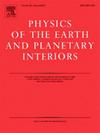关于水星的热演化和磁场的产生
IF 1.9
3区 地球科学
Q2 GEOCHEMISTRY & GEOPHYSICS
引用次数: 0
摘要
在水星的大内核中,通过对流进行的热传递可能仅限于固体内核和稳定分层的外层液体层之间的液体层。薄地幔中的对流甚至可能完全停止。在这里,我们考虑了地幔和地核的耦合热演化模型中从对流到传导性热传输的转变,并评估了磁场产生的影响。我们认为,导电温度分布最能描述地核中具有次绝热热通量区域的温度。在地核演化模型中在这些区域实施绝热,就像通常所做的那样,隐含地假设存在一种向下传递热量的机制。这种机制不仅消耗了本来可以用来维持发电机运转的能量,而且也不太可能有效。我们的研究表明,如果轻元素将水星核心的液体比铁降低几百度,那么在热分层层下方的水星液体核心深处的热对流层更有可能持续到现在。大量的轻元素进入液体核心可以在水星核心的上部驱动强烈的成分对流,但这可能不符合与观测到的磁场一致的发电机研究。因此,地核中轻元素显著降低地核液体但不强烈分馏成地核液体的热演化情景与现今的地核发电机最一致。现今在热分层层下的发电机作用并不一定意味着地幔目前是对流的。如果地幔具有高浓度的放射性元素和低粘度,那么它一定是对流的,但如果地幔具有较低的粘性和低浓度的放射性元素,那么地幔对流可能在现在之前就结束了。本文章由计算机程序翻译,如有差异,请以英文原文为准。

On the thermal evolution and magnetic field generation of planet Mercury
Heat transfer through convection in Mercury's large core may be limited to a liquid layer between a solid inner core and a stably stratified outer liquid layer. Convection in the thin mantle may even have entirely stopped. Here, we consider the transition from convective to conductive heat transport in a coupled thermal evolution model of the mantle and core and assess implications for the generation of the magnetic field.
We argue that a conductive temperature profile best describes the temperature in regions of the core with a subadiabatic heat flux. Implementing an adiabat in these regions in a model of the evolution of the core, as is often done, implicitly assumes the existence of a mechanism that transports heat downward. Such a mechanism not only consumes power that could otherwise be available for sustaining dynamo action, but is also unlikely to be effective.
We show that a thermally convective layer deep in Mercury's liquid core below a thermally stratified layer is more likely to persist until present if light elements depress the liquidus of the core by several hundred degree compared to iron. Substantial partitioning of light elements into the liquid core can drive strong compositional convection in the upper part of Mercury's core, but this may not be in line with dynamo studies that are consistent with the observed magnetic field. Therefore, thermal evolution scenarios with light elements in the core that depress the core liquidus significantly but do not strongly fractionate into the core liquid are the most consistent with the present-day core dynamo.
Present-day dynamo action below a thermally stratified layer does not necessarily imply that the mantle is currently convective. If the mantle has a high concentration of radiogenic elements and a low viscosity, it must be convecting, but mantle convection can have ended before the present for a more viscous mantle with low concentration of radiogenic elements.
求助全文
通过发布文献求助,成功后即可免费获取论文全文。
去求助
来源期刊

Physics of the Earth and Planetary Interiors
地学天文-地球化学与地球物理
CiteScore
5.00
自引率
4.30%
发文量
78
审稿时长
18.5 weeks
期刊介绍:
Launched in 1968 to fill the need for an international journal in the field of planetary physics, geodesy and geophysics, Physics of the Earth and Planetary Interiors has now grown to become important reading matter for all geophysicists. It is the only journal to be entirely devoted to the physical and chemical processes of planetary interiors.
Original research papers, review articles, short communications and book reviews are all published on a regular basis; and from time to time special issues of the journal are devoted to the publication of the proceedings of symposia and congresses which the editors feel will be of particular interest to the reader.
 求助内容:
求助内容: 应助结果提醒方式:
应助结果提醒方式:


